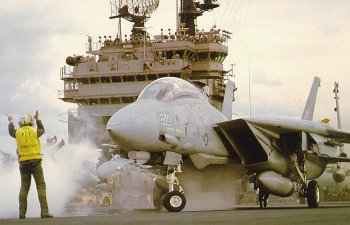The Grumman F-14 Tomcat was
designed as a fleet air-defense interceptor to replace the F- 4
Phantom II fighter (phased out in 1986). It is the latest in a long line of Grumman
"carrier cats" that date back to before World War II. Designed in the late
1960s, it was determined earlier on that the F-14 would be a "cat"; and since
the man behind the project  was Admiral Tom Connolly, then Deputy Chief
of Naval Operations for Air, the new airplane was instantly called Tom's Cat. was Admiral Tom Connolly, then Deputy Chief
of Naval Operations for Air, the new airplane was instantly called Tom's Cat. The F-14A was originally conceived to engage and
destroy targets at extreme range. It remains the US Navy's standard carrier-based
interceptor. The F-14 made its maiden flight on 21 December 1970. It has variable geometry
wings that can change shape in flight to match altitude conditions and speed needs. The
aircraft carries a crew of two, a pilot and a back-seater who operates the complex
offensive radar and weapons systems.
The heart of the Tomcat's unmatched prowess
is the combination of its Phoenix missile system and the powerful AWG-9 radar system. Its
advanced avionics suite represents the most capable long-range interceptor radar in
service, with the ability to detect, track and engage targets at ranges in excess of 160
km. America's aircraft carriers on duty in the Gulf can have no better protection than
F-14 Tomcats armed with the unerringly accurate Phoenix missile system. There is no
dispute that the Tomcats have become the Fleet Defenders.
Problems with the F-14A's TF-30 turbofan
were a key factor in the development of re-engined and upgraded Tomcat variants. The F-14B
emerged as an upgraded variant from the 14A, and was fitted with F101DFE engines. This
engine was developed into the GE F110-GE-400 turbofan, and was later selected to power
production improved Tomcat variants.
Two modified F-14As served as F-14D
prototypes and the first D model to be built as such made its maiden flight on 9 February
1990. Improvements introduced by the F-14D include NACES (Naval Aircrew Common Ejection
System) ejection seats, digital avionics with digital radar processing/displays, AN/ALR-67 radar warning receiver equipment and a dual undernose TCS/IRST sensor pod. The
F-14B and D have significantly more thrust than the F-14A, thus redressing the earlier
variant's power shortage.
In late 1995, the F-14A Tomcat acquired a
secondary air-to-ground role. They become bombers and were dubbed "Bombcats".
These new bombers carry only conventional "iron" bombs, and has no autonomous
PGM (Precision Guided Munitions) capability.

The F-14 Tomcat is prominently featured in the Paramount Pictures Inc. production "Top Gun" starring
Tom Cruise and Kelly McGillis. Another movie in which we can see the Tomcat in action is
"Final Countdown".

Click on the sound speakers and listen to the theme song
from Top Gun.
|